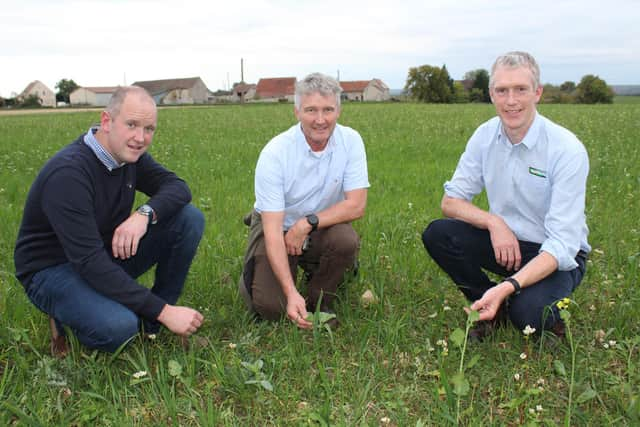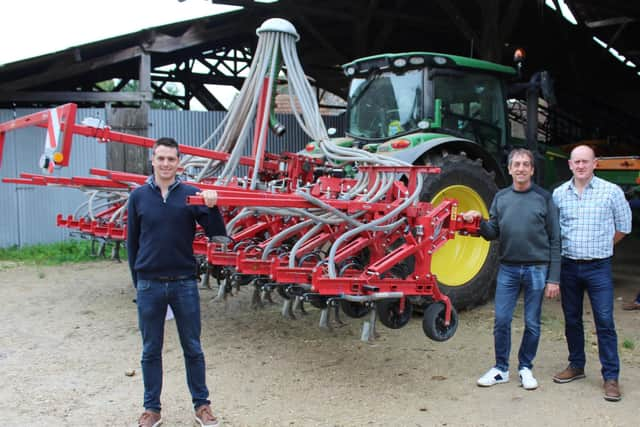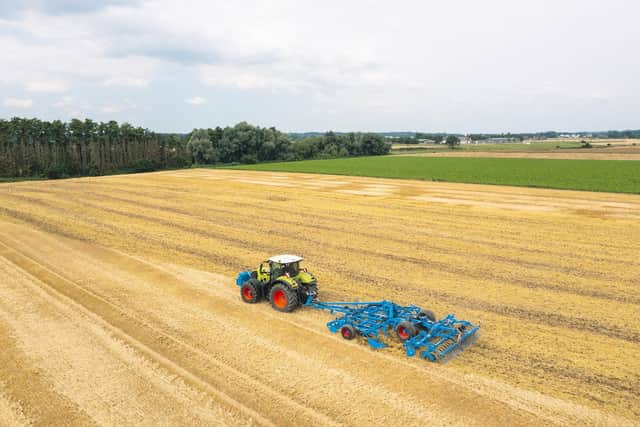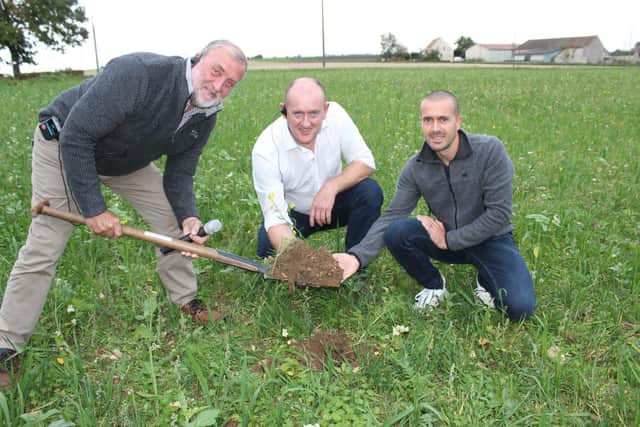The fast-changing face of French agriculture
and live on Freeview channel 276
But this has not been a one-off event for our European colleagues.
Farmers there are quick to point to the fact that drought conditions are now a common occurrence in most growing seasons.
Advertisement
Advertisement
They regard climate change as a reality: so how do they respond?


Increasing numbers of arable farmers in France are now looking at the option of certified organic production as a means of maintaining the viability of their businesses.
This trend has been driven by conviction, where some farmers are concerned.
However other factors coming into play include the availability of enhanced crop prices and the attractive, transition support packages on-offer from the French government.
Advertisement
Advertisement
A case in point is Alexandre Bardet, who farms with his brother Damien close to the city of Auxerre in the Yonne Valley.


Yonne is a department in the Bourgogne-Franche-Comté region in France. It is named after the river Yonne, which flows through it, in the country's north-central part.
One of Bourgogne-Franche-Comté's eight constituent departments, it is located in its northwestern part, bordering Île-de-France. It was created in 1790 during the French Revolution.
Over fifty percent of the inhabitants of the department are engaged in agricultural activities. It is one of the poorest and most rural departments in France.
Advertisement
Advertisement
During the hundred years leading up to 1962, its population declined by around 100,000, while all of the surrounding departments had population growth.


The Bardet family grow a mix of wheat, oilseed rape and sunflowers on their 900ha unit. They also own a vineyard, the grapes from which are used to produce Chablis.
The land is characterised by its gently rolling topography and shallow soils with their high stone and silt content.
Limestone is the predominant rock found in the region with the result that most soils have inherently high pH values: well above 7.0 in many cases.
Advertisement
Advertisement
Alexandre and Damien are transitioning their farm from conventional to organic status.


Previously, they had been able to achieve wheat yields of 5 -7t/ha. However, this has now dropped to a maximum of 2t/ha.
Helping the transition to organic status has been the inclusion of a sheep enterprise on the farm. They are stocked at a rate of 10 ewes per hectare and grazed on land prior to it being cropped.
By taking this approach, the dung produced by the animals acts as a valuable organic manure.
Advertisement
Advertisement
Soil erosion is a big threat to the many tillage farmers operating in the Yonne region.
The area is predisposed to very strong easterly winds for most of the year.
In order to minimise the erosion threat, cover crops are established after most crop harvests. Winter wheat is combined as early as June.


A group of Irish cereal and potato growers recently visited the Bardet farm.
The trip had been organised by Lemken Ireland.
Advertisement
Advertisement
They were informed that the impact of climate change had now become an imminent management challenge for farmers across the Yonne region.
Summer temperatures peaked this year at 45°C with little or no rain falling in the weeks running up to harvest.
Adding to the challenges faced by the Bardet family is the fact that conventional wheat prices strengthened considerably in 2022, leaving the margins to be secured from organic grain at very minimal levels.
Margins across their business were also hit by the fact that the French wine sector has come under severe economic pressure over the past two years.
Advertisement
Advertisement
Given that increasingly hot and dry summers now seem to be an inevitable consequence of climate change, the Bardet family have joined forces with nine neighbouring farmers to establish a solar energy project.
The coming months will see 38ha of land given over to solar panels. The diversification project will be supported by the French government.
It is also envisaged that the sheep currently grazing the cover crops established on the Bardet farm will be used to control the vegetation that grows up between the individual solar panels.
An absolute commitment to the highest standards of precision management is a hallmark of France’s organic farmers to their production practises.
Advertisement
Advertisement
And this principle extends well beyond weed control: it also includes the optimal use of land on which to grow crops.
The recent, Lemken-hosted, visit to France by a group of Irish cereal and potato growers included a stop-off at the farm of the Rousselat family.
The father and son team, Jean Cristoph and Arnaud, grow a mix of wheat, sugar beet, sunflowers, soya and alfalfa close to the village on Neully in the Yonne region.
They are committed to organic production practices. However, they fully recognise the need to trial and introduce new crop management practises, in order to maintain the sustainability of their business.
Advertisement
Advertisement
The land they are working features soils with very high clay contents. Limestone comes very close to the surface across all of the farm. Soil pH values are very high, in the region of 8.4. As a consequence, soil available phosphate levels are very low.
Effective crop rotation is at the very heart of the Rousselat business model.
From a crop management perspective, effective mechanical weed control is critically important. For the most part this is achieved using a precision hoeing system, manufactured by Steketee.
Making this work in a cereal setting requires crop row width to be extended to 25cms.
Advertisement
Advertisement
However, this degree of spacing allows for alfalafa and soya to be planted out between the rows of wheat during the months of April and May.
To make this happen, Jean Cristoph and Arnaud have specifically attached a seed drill to the Steketee hoe.
This then delivers a combination of weed control and the establishment of the additional at the same time.
Water availability to crops is a constant challenge for farmers in the Yonne region of eastern France.
Advertisement
Advertisement
In the case of Jean Cristoph and Arnaud Rousselat, they are currently trialling the use of active charcoal pellets as a way of retaining moisture throughout the growing season.
They are also allows to use poultry litter pellets as a fertiliser source. These are sourced from Belgium and the Netherlands.
Another feature of the Rousselats’ approach to crop production is their use of microorganism-based spray solutions to stimulate both crop growth and enhance inherent levels of disease resistance.
This year has seen Jean Cristoph and Arnaud Rousselat achieving organic wheat yields of 3t/ha.
Advertisement
Advertisement
Their soya crops came in at 0.4t/ha. These figures are well down on projected levels, as a result of the extreme drought conditions that gripped their region for most of the 2022 growing season.
The Lemken-hosted trip to France brought together a group of arable farmers from across the island of Ireland and journalists. It took place in mid-October, just as the autumn rains started to fall.
While the actual farm visits were of tremendous interest, of equal significance were the discussions held amongst the travelling group as they made their way from one location to the next.
One of the most fundamental points raised concerned the actual future of ploughing and its continuing use as a core cultivation technique.
Advertisement
Advertisement
It is now obvious that arable farmers are grappling with an the fast-expanding range of crop establishment options that are now available to them: ploughing, followed by a traditional cultivation approach; min-till or zero-till.
The consensus view amongst the group of visiting farmers was that all cultivation techniques should remain available to them including, the use of the plough.
And, specifically, future grant schemes should reflect this principle.
The future role of machinery manufacturers and distributors in lobbying for schemes that more specifically meets this need was discussed.
Advertisement
Advertisement
The discussion on the future prospects for ploughing was sparked by a presentation given to the travelling group on the latest research taking place in England to control Blackgrass.
Work carried by Agrii, a leading agronomy company with a research centre in East Anglia, has confirmed that ploughing acts as an effective means of controlling the weed within a cereal rotation.
While GB has a systemic Blackgrass problem, other fast-changing agronomic challenges are now confronting arable farmers here. One of these is how best to incorporate straw into soils after chopping.
The debate that was had on this subject amongst the members of the visiting group concentrated on two main issues.
Advertisement
Advertisement
The need to have the straw chopper set up properly behind the combine is critical. Straw must be spread as widely as possible in order to maximise the opportunity for contact to be made with the soil.
Secondly, straw must be given sufficient time to break down between crops. This process should start to take place very quickly after chopping, assuming there is good contact between the soil and the trash.
However, there is a perception that straw incorporation can lead to increased slug related-problems within a newly established crop.
The visit to France provided Lemken with an opportunity to confirm the company’s commitment to, more effectively, combine mechanical weed control and herbicide spraying technologies
Advertisement
Advertisement
Herbicide application rates within vegetable crops can be reduced substantially through the use of mechanical weed control between rows while band spraying herbicide only within rows.
According to Lemken, this is now possible courtesy of its Steketee ‘EC-Weeder’ range, which features the inclusion of a front mounted SprayHub tank.
This is connected to the rear-mounted hoeing machine via a ‘SprayKit’ application.
Combining the two elements ensures that concentrated spraying only takes place within rows.
Advertisement
Advertisement
As a result, growers can reduce spray agent volumes by between 40% and 60% .
The weed control combo also acts to reduce manual labour costs, as hoeing and spraying are carried out in a single pass.
The SprayHub combines all necessary functions for the speed-responsive application of spraying liquids.
The front tank is equipped with its own controls, agitator and cleaning system for this purpose.
Advertisement
Advertisement
It is ISOBUS-controlled and can be intuitively operated via the MegaSpray software.
The SprayHub comes with a tank capacity of 1,100 or 1,500 litres and features a clean water tank, hand wash canister and filling screen.
An additional induction nozzle is available for dissolving solid agents. A CTS connection for contactless induction is also available.
The SprayKit can also be used with a range of other implements. Significantly, it features mechanical section control.
Advertisement
Advertisement
Single row control is planned as a next step, allowing automatic section control via GPS.
The application technology of the Steketee EC Weeder has been optimised for convenient use with the SprayHub.
The height-adjustable nozzle holder is equipped with a scale to easily adjust the desired spraying height and position.
This allows the width of the required spray band to be individually determined depending on row spacing, crop and type of application. Different nozzles can be used depending on the individual application.
Special band spraying nozzles ensure a uniform concentration of spraying liquid across the set band width.